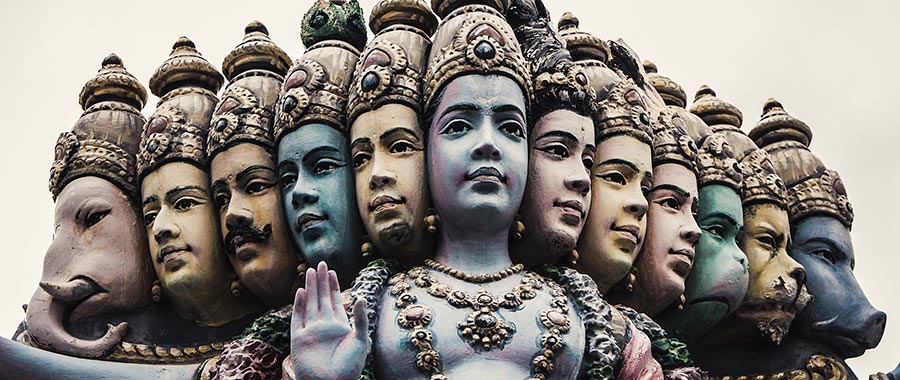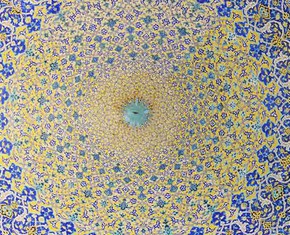The views expressed in our content reflect individual perspectives and do not represent the authoritative views of the Baha'i Faith.
Hinduism is best described as a family of religions. One major (the most populous) group within Hinduism is the worship of the God Vishnu and His Avatars.
This important Hindu sub-tradition is known as Vaishnavite Hinduism (i.e. Vaishnavism or Vishnuism).
Baha’is believe that Baha’u’llah, according “to the Hindus” is “the reincarnation of Krishna.” – Shoghi Effendi, God Passes By, p. 94. “To [Baha’u’llah],” Shoghi Effendi further states, “the Bhagavad-Gita of the Hindus had referred as the ’Most Great Spirit,’ the ’Tenth Avatar,’ the ‘Immaculate Manifestation of Krishna’.” – Ibid.
Here, the “reincarnation of Krishna” is analyzed and described as the “Tenth Avatar,” which is the Kalki Avatar. However, since Baha’is do not believe in reincarnation as such, here Baha’is understand the “reincarnation of Krishna” to mean the return of the previous spirit and power of Krishna—not as the literal return of Krishna’s individuality or soul.
Krishna is the Eighth Avatar. So why does the Eighth Avatar return as the Tenth Avatar, and not as the Ninth Avatar? That’s because the Ninth Avatar is the Buddha, who (according to Vaishnavite Hindu texts) was sent to deceive and lead people astray! This is a classic instance of the assimilative powers of the ancient Hindu tradition, which can absorb almost any religious belief under its umbrella.
Although the Bhagavad-Gita, the most popular of all Hindu texts, does not mention Kalki directly, the Mahabharata, the great Indian epic of which the Bhagavad-Gita is a part, definitely does:
“A Brahmin by the name of Kalki Vishnuyashas will be born, impelled by Time, in the village of Shambhala.” – Mahabharata 3.188.89a, quoted by Wendy Doniger in The Hindus: An Alternative History, p. 486.
This quote is taken from a longer passage in the “Book of the Forest” in the Mahabharata:
And when the end of the Yuga comes, crops will not grow in abundance. And the women will always be sharp in speech and pitiless and fond of weeping. And they will never abide by the commands of their husbands. And when the end of the Yuga comes, sons will slay fathers and mothers. And women, living uncontrolled, will slay their husbands and sons. … And when the end of the Yuga comes, men will cast away and neglect their friends and relatives and attendants. …
And when those terrible times will be over, the creation will begin anew. And men will again be created and distributed into the four orders beginning with Brahmanas. And about that time, in order that men may increase, Providence, according to its pleasure, will once more become propitious. And then when the Sun, the Moon, and Vrihaspati will, with the constellation Pushya, enter the same sign, the Krita age will begin again.
And the clouds will commence to shower seasonably, and the stars and stellar conjunctions will become auspicious. And the planets, duly revolving in their orbits, will become exceedingly propitious. And all around, there will be prosperity and abundance and health and peace. And commissioned by Time, a Brahmana of the name of Kalki will take his birth. And he will glorify Vishnu and possess great energy, great intelligence, and great prowess. And he will take his birth in a town of the name of Sambhala in an auspicious Brahmana family.
And vehicles and weapons, and warriors and arms, and coats of mail will be at his disposal as soon as he will think of them. And he will be the king of kings, and ever victorious with the strength of virtue. And he will restore order and peace in this world crowded with creatures and contradictory in its course. And that blazing Brahmana of mighty intellect, having appeared, will destroy all things. And he will be the Destroyer of all, and will inaugurate a new Yuga. And surrounded by the Brahmanas, that Brahmana will exterminate all the mlecchas wherever those low and despicable. – The Mahabharata, Book 3: Vana Parva, Section CLXXXIX, translated by Kisari Mohan Ganguli, p. 390.
In the previous four articles in this “Figuring Out Prophecy” series, we have looked at Baha’u’llah’s identification as Kalki, the future Avatar of Hindu prophecy. We will now examine the prophecy of Krishna’s return, and the claim that Baha’u’llah has fulfilled that prophecy as well.
Baha’is refer to prophets or messengers of God as “Manifestations of God.” This term is different from an “Incarnation of God,” as in Christian usage. Baha’u’llah clearly states: “Know thou of a certainty that the Unseen can in no wise incarnate His Essence and reveal it unto men.” – Gleanings from the Writings of Baha’u’llah, p. 49. Baha’is believe that these “Manifestations of God,” have appeared throughout history, bringing progressive teachings. This Baha’i teaching is known as “Progressive Revelation.”
Similarly, certain Hindu texts recount the successive appearance of “manifestations” of Vishnu. For example, the term “avatāra” is Sanskrit. Often translated as “incarnation,” the Sanskrit word “avatāra” literally means “descent.”
In its Anglicized form, the term “avatar” has entered the English language, and has taken on a range of additional meanings. The Oxford English Dictionary defines “avatar” as: “1. Hindu Mythol. The descent of a deity to the earth in an incarnate form. 2. Manifestation in human form; incarnation.”
The Sanskrit term “avatāra” was actually preceded by another word, “prādurbhāva,” which means “manifestation.”
The doctrine of avatāras is presented in Bhagavad-Gita 4.7–8, in this famous prophecy by Krishna:
Whenever there is a decline in righteousness and an increase in unrighteousness, O Arjun, at that time I manifest myself on earth.
To protect the righteous, to annihilate the wicked, and to reestablish the principles of dharma I appear on this earth, age after age. – Bhagavad Gita: The Song of God, translated by Swami Mukundananda, pp. 138–139.
In London, on October 24, 1911, Abdu’l-Baha explained regarding Krishna:
An Indian said to Abdu’l-Baha: “My aim in life is to transmit as far as in me lies the message of Krishna to the world.” Abdu’l-Bahá said: “The Message of Krishna is the message of love. All God’s prophets have brought the message of love.” – Abdu’l-Baha, Paris Talks, p. 35.
The Baha’i belief in Krishna as a past “Manifestation of God” is significant in the Baha’i effort to unite East and West, where the twain may meet.
So who was Krishna? Historical? Legendary? Mythological? That will be the subject of the next article in this series.
















Comments
Sign in or create an account
Continue with Googleor